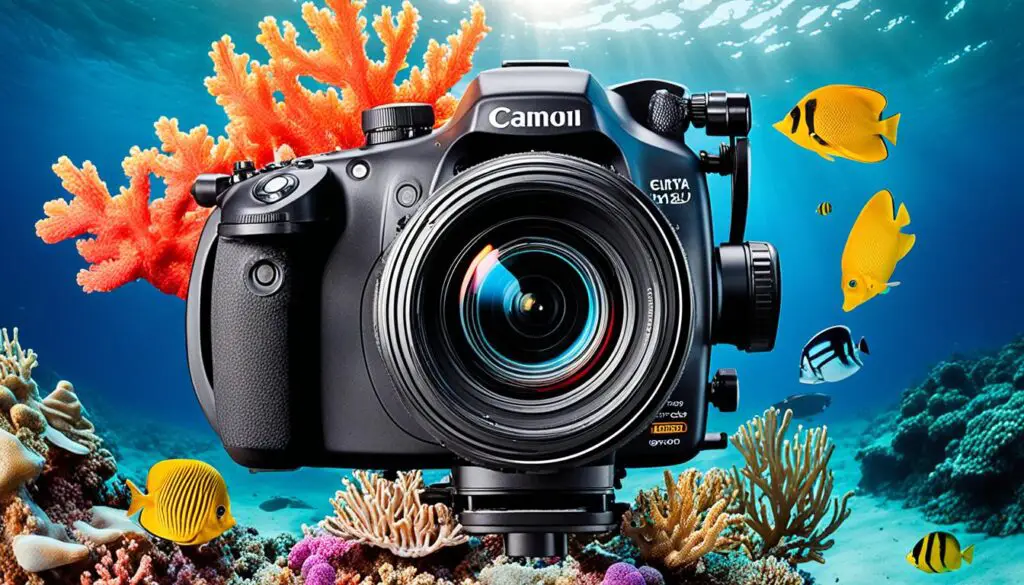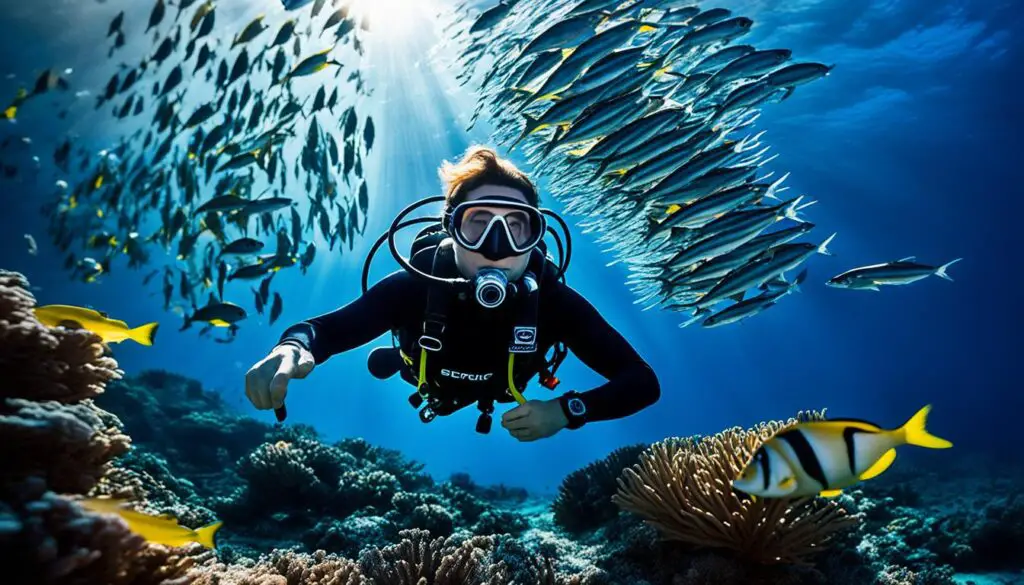Underwater photography allows you to capture the beauty and mystery of the aquatic world. Whether you’re a beginner or an experienced photographer, here are some tips and tricks to help you perfect your underwater shots.
Exploring the underwater realm is like diving into a whole new world, filled with stunning marine life, vibrant colors, and fascinating landscapes. As you dive deeper, you’ll encounter unique challenges that require specialized skills and equipment to overcome. Knowing the right techniques and mastering the art of underwater photography will not only enhance your images but also allow you to share the wonders of the aquatic world with others.
From choosing the right equipment to editing your photos, this guide will provide you with valuable insights and practical advice to take your underwater photography to the next level. So, let’s dive in and discover the secrets of capturing breathtaking images beneath the surface!
Key Takeaways:
- Underwater photography enables you to capture the awe-inspiring beauty of the aquatic world.
- Choosing the right equipment, including a high-quality camera, housing, and lights, is crucial for successful underwater photography.
- Mastering composition, lighting, shooting modes, and white balance techniques is essential for capturing stunning underwater photos.
- Edit your underwater photos to enhance their quality through color correction, contrast adjustments, and saturation levels.
- Experiment, practice, and continue learning to improve your underwater photography skills and create captivating imagery.
Choosing the Right Equipment for Underwater Photography
Before diving into the fascinating world of underwater photography, it’s crucial to ensure you have the right equipment. The quality of your gear can make a significant impact on the outcome of your photographs. Here, I’ll guide you through the essential underwater photography equipment and how each component contributes to capturing breathtaking images.
1. Underwater Camera
An underwater camera is the heart and soul of your photography setup. Look for a camera specifically designed for underwater use, as they are built to withstand the challenging conditions beneath the surface. A high megapixel count ensures clarity and detail in your photos, while a wide-angle lens allows you to capture the expansive beauty of the marine environment.
2. Waterproof Housing
While underwater cameras are designed to be water-resistant to some extent, investing in a sturdy waterproof housing is essential for ultimate protection. These housings provide an extra layer of defense, safeguarding your camera against water damage and allowing you to explore deeper depths without worry.
3. Underwater Lights
Lighting plays a crucial role in underwater photography, as the colors and details can be lost in the depths. Underwater lights provide additional illumination, allowing you to overcome the challenges posed by limited natural light. These lights bring out vibrant colors and enhance the overall quality of your images, making them more captivating and lifelike.
Remember, choosing the right equipment sets the foundation for successful underwater photography. Invest in reliable and high-quality gear to ensure you capture the beauty of the underwater world with utmost precision and artistry.

Comparison of Popular Underwater Cameras
| Camera Model | Megapixel Count | Wide-Angle Lens | Waterproof Housing |
|---|---|---|---|
| Nikon D850 | 45.7 MP | Yes | Available |
| Canon EOS 5D Mark IV | 30.4 MP | Yes | Available |
| Sony Alpha A7R IV | 61 MP | Yes | Available |
Mastering Underwater Photography Techniques
To capture stunning underwater photos, mastering key techniques is essential. By paying attention to composition, lighting, shooting mode, and white balance, you can bring your underwater images to life.
Composition:
Composition plays a vital role in creating balanced and visually appealing images. Utilize the rule of thirds, a fundamental principle in photography, to guide your composition. Imagine your frame divided into a 3×3 grid and position your subject along the lines or at the intersection points. This technique adds interest and depth to your photos, making them more engaging to the viewer.
Lighting:
Lighting is crucial in underwater photography, as it can significantly impact the overall aesthetic of your images. Natural light can create beautiful and ethereal effects, especially in clear waters with sunlight streaming through. However, in darker conditions or deeper dives, artificial lighting becomes necessary to illuminate your subjects properly. Experiment with different lighting setups and techniques to achieve the desired mood and highlight the details of your underwater world.
Shooting Mode:
The shooting mode you choose determines how your camera captures the scene. Underwater, the subjects are often dynamic and constantly moving. To freeze the action and capture precise moments, switch to the continuous shooting or burst mode. This allows you to take multiple shots in rapid succession, increasing your chances of capturing the perfect moment.
White Balance:
Underwater environments can create color casts due to the water’s natural filter. Adjusting the white balance setting on your camera helps restore accurate colors in your photos. If shooting in a shallow dive with clear blue waters, choose the “Daylight” or “Auto” white balance setting. For deeper dives or when encountering color casts, use the custom white balance or underwater preset to correct the colors and bring out the natural vibrancy in your images.
Remember, mastering these techniques takes time and practice. Take every opportunity to refine your skills and experiment with different approaches. The more you dive into the world of underwater photography, the better you’ll become at capturing breathtaking images that truly showcase the beauty of the aquatic realm.

In the next section, we’ll explore editing tips to enhance the quality of your underwater photos and bring out their full potential.
Editing Tips for Underwater Photos
After capturing your underwater photos, it’s time to edit them to enhance their quality and bring out their full potential. With the right editing techniques, you can transform your raw images into stunning works of art.
Start by using editing software to adjust the exposure, color balance, and sharpness of your images. Underwater photography often suffers from color casts caused by the water, so color correction is crucial to restore the natural hues. By fine-tuning the contrast and saturation, you can make your photos more vibrant and eye-catching, capturing the vivid beauty of the underwater world.
When it comes to editing, don’t be afraid to get creative and experiment with different techniques. Play around with filters, textures, and overlays to add depth and visual interest to your photos. Remember that editing is a personal process, and there are no strict rules. Trust your artistic instincts and let your imagination guide you towards achieving the desired look for your underwater shots.
FAQ
What is underwater photography?
Underwater photography is the art of taking photographs underwater. It allows photographers to capture the beauty and mystery of the aquatic world.
What equipment do I need for underwater photography?
To get started with underwater photography, you’ll need a good underwater camera with a high megapixel count and a wide-angle lens. Additionally, you’ll need a sturdy waterproof housing to protect your camera from water damage. Investing in underwater lights can also help illuminate your subjects and enhance the colors in your photos.
What techniques should I use for underwater photography?
When it comes to underwater photography, composition and lighting are key. Pay attention to your composition by using the rule of thirds to create visually appealing images. Experiment with different shooting modes and adjust your white balance to achieve the perfect colors. Additionally, consider using artificial lighting in darker conditions or rely on natural light to create beautiful effects.
How can I edit my underwater photos?
After capturing your underwater photos, editing is an important step to enhance their quality. Use editing software to adjust the exposure, color balance, and sharpness of your images. Color correction can help eliminate any unwanted color casts caused by water, while increasing the contrast and saturation can make your photos more vibrant and eye-catching. Don’t be afraid to experiment with different editing techniques to achieve the desired look.
